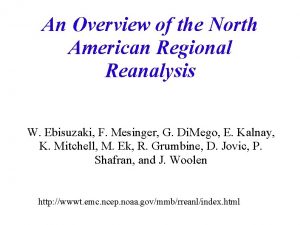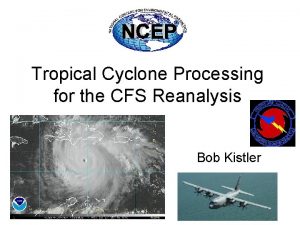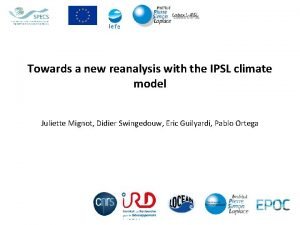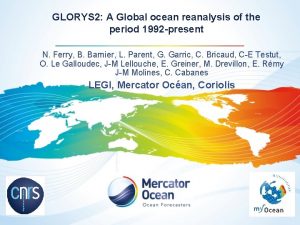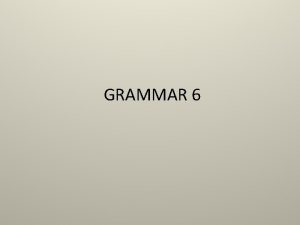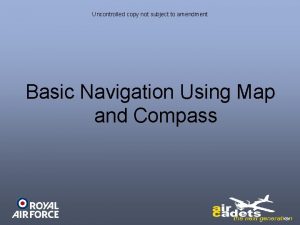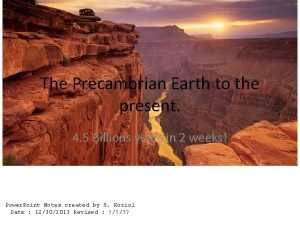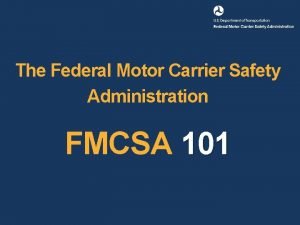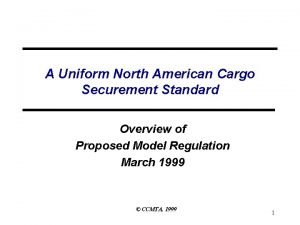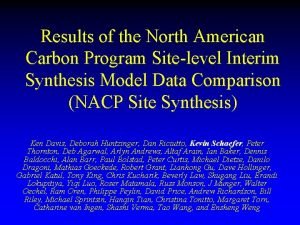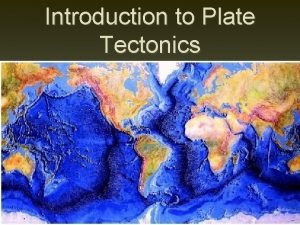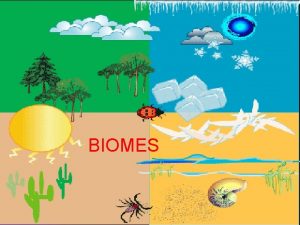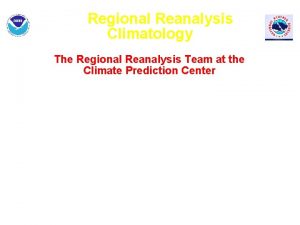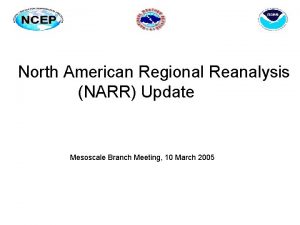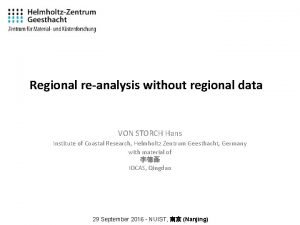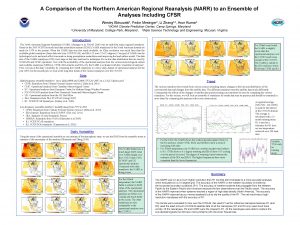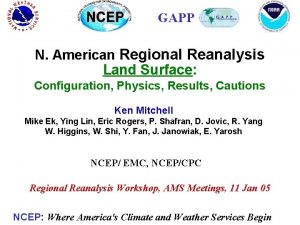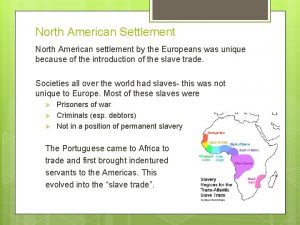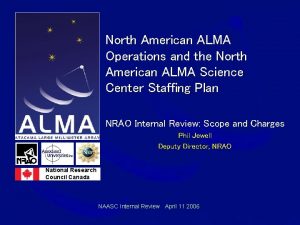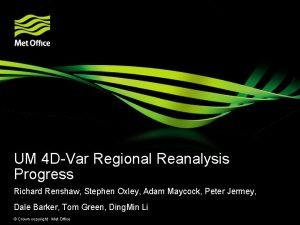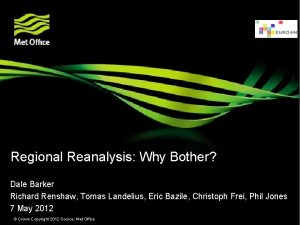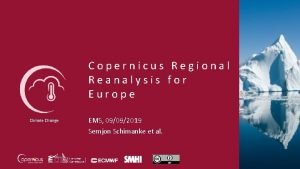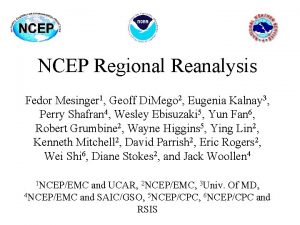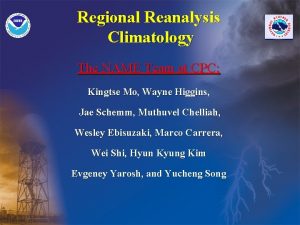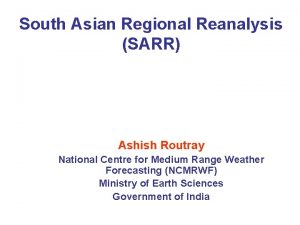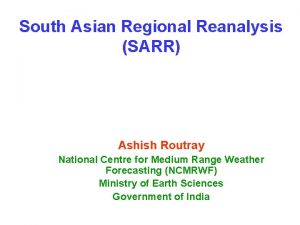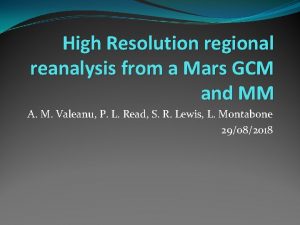An Overview of the North American Regional Reanalysis


































- Slides: 34

An Overview of the North American Regional Reanalysis W. Ebisuzaki, F. Mesinger, G. Di. Mego, E. Kalnay, K. Mitchell, M. Ek, R. Grumbine, D. Jovic, P. Shafran, and J. Woolen http: //wwwt. emc. ncep. noaa. gov/mmb/rreanl/index. html

Motivation for North American Regional Reanalysis (NARR) ● ● Create hi-resolution reanalysis for the North American domain Address some of the weakness of the N/N Reanalysis, i. e. , near surface temperature, winds Hydrology in the North American domain Make a more useful reanalysis (for people who want point values and live on the surface Expectations ● more applied meteorological applications ● more uncertain about how non-meteorologists will use the data

High Lights of NARR ● ETA model and assimilation system (EDAS) ● 32 km resolution over the North and Central America ● R-2 horizontal boundary conditions ● new land surface model (NOAH) ● precipitation assimilation ● 8 x daily analyses from October 1978 onwards ● 5 TB for basic set of analyses and fluxes ● Oct 1978 -Nov 2002 done

NARR domain

180 km (~ CDAS) vs 32 km (NARR) resolution topography

ETA / NOAH LAND-SURFACE MODEL UPGRADES: 24 Jul 01 - assimilation of hourly precipitation -- hourly 4 -km radar/gage analysis (Stage IV) - cold season processes(Koren et al 1999) -- patchy snow cover -- frozen soil (new state variable) -- snow density (new state variable) - bare soil evaporation refinements -- parameterize upper sfc crust cap on evap - soil heat flux -- new soil thermal conductivity (Peters-Lidard et al 1998) -- under snowpack (Lunardini, 1981) -- vegetation reduction of thermal cond. (Peters-Lidard et al 1997) - surface characterization -- maximum snow albedo database (Robinson & Kukla 1985) -- dynamic thermal roughness length refinements - vegetation -- deeper rooting depth in forests -- canopy resistance refinements NOAH LSM tested in various land-model intercomparison projects, e. g. , GSWP, PILPS 2 a, 2 c, 2 d, 2 e, Rhone, and (near-future) DMIP.

January 1997 Precipitation Results

Precipitation ● Several sources of precipitation – – CONUS data with PRISM (Mountain Mapper) to improve orographic effects Canada Mexico CMAP (combination of satellite and gauge data) over oceans; CMAP is blocked: ● ● ● Near central areas of hurricanes (7. 5 by 7. 5 deg) Observed precipitation > 100 mm/day A 15 -degree 'blending belt' between 27. 5 and 42. 5 N, with no CMAP north of 42. 5 N

Comparison of N/N Reanalysis and NARR model ● Global ● N. Am. Sector ● Spectral ● Grid point ● ~250 km resolution ● 32 km resolution ● 28 sigma levels ● 45 pressure levels ● Land sfc (Pan and Marht, 1987) ● NOAH model (2002) ● One soil type (sandy loam) ● Realistic soil types ● Two soil levels ● 4 soil layers ● Simplistic snow depth, fn(T) ● Snow depth, modeled/observed ● 6 hour analyses time steps ● 3 hour analyses time steps

Comparison of N/N Reanalysis and NARR input observations ● Sondes, aircraft, profilers ● TOVS temperature retrievals ● Direct assimilation of radiances ● Satellite winds ● Land sfc: prs, q, winds ● Ocean sfc: prs, q, t, winds ● Precipitation ● Snow cover: old is low res ● USAF snow depth (hi res) ● Reynold's SST + lakes ● Sea ice from R. Grumbine + lakes

Comparison of N/N Reanalysis and NARR dates ● Software: ~1994 ● Software: ~2002 ● Analyses: 1948 -present ● Analyses: Oct 1978 -Nov 2002 ● Nov 2002+ in development

Operational ETA vs NARR ● 12 km ● 32 km ● 60 levels ● 45 levels ● Evolving physics ● Frozen physics ● Precip assim for CONSUS ● Better precip obs ● Lakes: SST, ice-real time ● Better lake obs

Operational ETA vs NARR User Output: RR is more friendly ● RR: 1 grib table vs 3 grib tables for OPN (some software cannot handle multiple tables) ● RR: Winds are N/S vs grid-relative winds in OPN (some software cannot handle grid-relative winds) ● RR: new variables: moisture fluxes, etc ● RR: redundant variables removed: ex dew pt, rel q, specific q ● RR: added new BL levels, removed others ● RR: BUFR files have QC and increments ● RR: many monitoring plots

Why NARR should have better surface values 1) higher horizontal orography: 32 km vs ~250 km need to resolve orography 2) better land surface model to get 2 m temp and q. . need better sfc fluxes 3) assimilated precipitation better model precipitation. . clouds, radiative flux better soil moisture. . latent and sensible heat flux 4) gridded snow depth is similar to NARR resolution a problem with NCEP's global reanalyses 5) assimilate more near surface data (winds, q) 6) 3 hour assim cycle, better resolve diurnal cycle
















Principal Output Datasets ● Observations with QC marks, increments (BUFR) ● plots: obs locations, fit to sondes, fit to sfc obs, ● fit to global reanalysis, various NARR fields ● binary restart files (to rerun model, high resolution), very big, small usage ● GRIB analyses and first guess on model grid big, no interpolation errors ● ● GRIB analyses and first guess on Lambert conformal 32 -km grid, big, easier to use, interpolation error Merged: GRIB analyses and averaged/accumulated flux/precip and some 1 st guess fields for water budgets, Lambert Conformal grid (AWIP 221), 5 TB for 8 x daily for entire period. This will be work-horse data set.

Data Distribution ● ● NCAR SDSC (San Diego Super Computing Center, UCSD) U. of Maryland NCDC-NOMADS (NOAA Operational Model Archive Distribution System)

NOMADS ● ● Partnership of many organizations including core collaborators: CDC, COLA, FSL, GFDL, LLNL, NCAR, NCDC, NCEP, PMEL, UNIDATA On-line access to the merged RR data set (analyses + fluxes+some first guess) – NCDC: 7 TB on-line storage, web servers, x-TB tape storage – NCEP: ¾ TB on-line, web servers, software upgrades Software: – on-line plotting package – on-line slice-and-dice of GRIB files – Gr. ADS-DODS Status: – plotting package will be enhanced by NCEP – downloading of GRIB files will be enhanced by NCEP – Gr. ADS-DODS needs enhancements – NOMADS-NCDC has experience running software

I can't download the 5 TB merged data set! Download what you want: Select: 1) variables 2) levels 3) times 4) domain 5) resolution: 32 km, 64 km, 96 km Downloading can be scripted

Summary Oct 4, 2003 Finished Oct 1978 to mid-Nov 2002 no more inland lake data no 2003 Canadian precip currently planning the real-time NARR will use different datasets as some precip/lake data are not available in real time currently planning subsets and archive Dec 2003 internet-2 will be available at NCDC and distribution to archive sites can start Until NARR appears at archive sites, you can look at 1 year of merged data at NCEP. http: //wwwt. emc. ncep. noaa. gov/mmb/rreanl/index. html
 North american regional reanalysis
North american regional reanalysis Tcvitals
Tcvitals Eric guilyardi
Eric guilyardi Glorys reanalysis
Glorys reanalysis Nctrca application
Nctrca application American literature overview
American literature overview American literature overview
American literature overview The north pole ____ a latitude of 90 degrees north
The north pole ____ a latitude of 90 degrees north True north vs magnetic north
True north vs magnetic north North east and north cumbria integrated care system
North east and north cumbria integrated care system Lesson 1 the industrial north
Lesson 1 the industrial north North american craton
North american craton North american air masses
North american air masses North american colonies
North american colonies North american mission board employment
North american mission board employment Fmcsa north american standard level i course online
Fmcsa north american standard level i course online North american gaming regulators association
North american gaming regulators association Tiedowns in the eyes crosswise orientation should
Tiedowns in the eyes crosswise orientation should North american carbon program
North american carbon program Laissez faire theory
Laissez faire theory Why are cold fronts steeper than warm fronts
Why are cold fronts steeper than warm fronts North american portal
North american portal North american association for environmental education
North american association for environmental education North american plate
North american plate Color the north american biomes
Color the north american biomes Nafta
Nafta Mobile baptist association
Mobile baptist association Thiếu nhi thế giới liên hoan
Thiếu nhi thế giới liên hoan Các số nguyên tố là gì
Các số nguyên tố là gì Fecboak
Fecboak Các châu lục và đại dương trên thế giới
Các châu lục và đại dương trên thế giới Một số thể thơ truyền thống
Một số thể thơ truyền thống Thế nào là hệ số cao nhất
Thế nào là hệ số cao nhất Hệ hô hấp
Hệ hô hấp Tư thế ngồi viết
Tư thế ngồi viết
